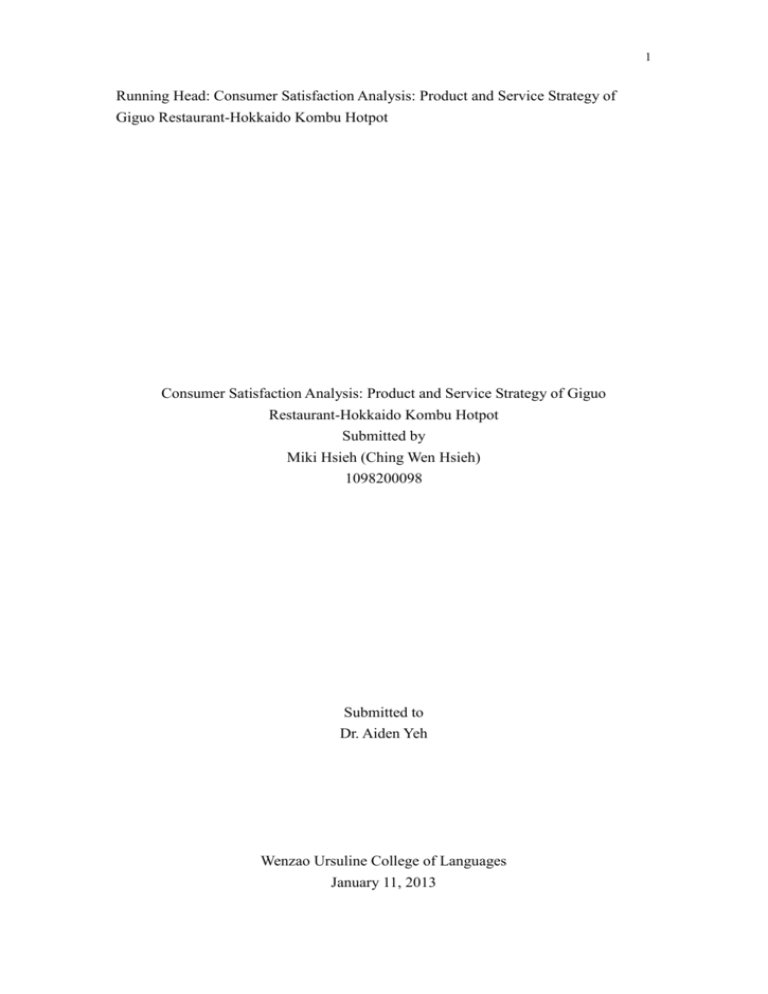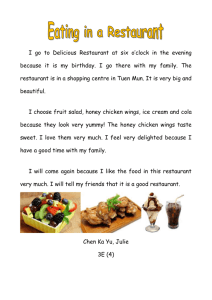1 Running Head: Consumer Satisfaction Analysis: Product and
advertisement

1 Running Head: Consumer Satisfaction Analysis: Product and Service Strategy of Giguo Restaurant-Hokkaido Kombu Hotpot Consumer Satisfaction Analysis: Product and Service Strategy of Giguo Restaurant-Hokkaido Kombu Hotpot Submitted by Miki Hsieh (Ching Wen Hsieh) 1098200098 Submitted to Dr. Aiden Yeh Wenzao Ursuline College of Languages January 11, 2013 2 TABLE OF CONTENTS Introduction: ……………………………………………………………… . 3 Background: ……………………………………………………………… . 5 Theoretical Framework: ………………………………………………… 7 Methodology: ………………………………………………………………. 9 References: ……………………………………………………………… . 10 Appendix Consent/Cover Letter ……………………………………………………… 10 Questionnaire/Interview Questions ………………………………………… 12 3 Introduction: Nowadays, customers go to restaurant not just caring the food and also caring the importance of experiences, which are characterized as satisfying customers’ psychic or personal needs. Moreover, in this theory, customers care more about the experiences that are provided by marketers, and they are willing to pay for them (Ting Yueh Changa and Shun Ching Horng, 2008). Also, the National Restaurant Association’s list of the top 20 food trends for 2010 suggests that we are making decisions based on our health and the environment (NRA, 2010). Next, we can know that in the food service society, consumers start to care about eating healthier food and enjoying the high quality of service while they are eating meals. Good service as well as good product, food in the restaurant for customers plays a significant role to decide how good loyalty to keep visiting Giguo restaurant. In the last several years, customers’ experiences become more and more important. Today, in fierce competition environment, it is not enough to just follow the tradition rules of service, but caring a slightly different way of thinking about customers’ needs. It is recognized that many restaurant managers or cook work on enhancing customers’ overall experience during consumption, for example a successful Chinese restaurant in Taiwan-Giguo Restaurant-Hokkaido Kombu Hotpot. The study of Namkyung and Jang (2007) explained through their research that healthy ingredients showed a strong relationship with behavioral intention, however no significant influence on customer satisfaction. Therefore, restaurants should focus on the effects of attributes of foods and services that influence both customer satisfaction and as well as behavioral intention. According to this study, we can know that the factors of food and service change consumers’ satisfaction. In addition, previous service experiences normally dictate how customers will act upon their restaurant dining experience. In general, once a customer has received an excellent and memorable experience, they will express favorable behavioral intentions in the future. Favorable behavioral intentions can include recommending the restaurant to others, spreading positive word of mouth, and becoming a loyal customer (Boulding, Kalra, Staelin, & Zeithaml, 1993; Reichheld & Sasser, 1990). We can know that the healthier food was traced from Japan and more importantly the elder were living longer and longer than other countries. According to this study, we can understand why reasons appeal consumers to buy its products. Also, this paper would like to investigate what makes it success, what newly experience managers offering to their customer. Finally, according to this paper, we can know how food and service strategies attract consumers to meet their needs. Meanwhile, it is possible and worth others to follow or learn from it. 4 Purpose of the study The purpose of this research is to study the market situation and consumers’ satisfaction with food and service in Giguo restaurant. According to Pine and Gilmore, “value added usually comes from product, service and experience. The former adds less and the latter adds more. Experience can offer higher value because it is personal and memorable”. The research focuses on what the crucial attractions are to identify the wants and needs of consumers. Therefore, consumers’ needs make the strategies developing well in Giguo restaurant. What consumers’ satisfaction in marketing contained price, and place is so important to Giguo restaurant. In the end, this study can prove that these factors will affect consumers’ satisfaction indeed. Importantly, in the future these information will offer the restaurant managers to decide the right direction precisely. Limitation of the study During the research, there are not always for me finding the perfect and complete answers to the questions. In fact, there are two major limitations in my study. First, there is not much information about Giguo restaurant in English. I have to translate each sentence. Second, it is the empirical part and there is not easy to collect questionnaires from people who had experiences eating a little higher price of Giguo restaurant, especially for students as me. Besides, it is not easy to get the first information from Giguo restaurant. No matter how difficult to analyse the papers or how hard to find the answers, the final purpose is to achieve the goals. For example, I will try to apply for a part time job in Giguo restaurant in the winter vacation or do the survey. Background: In this study, we can know how good service and product can appeal to the consumers repurchase in the competitive hotpot restaurant market. Furthermore, to be successful, the focus of this research will be on one key aspect of service experience, namely the customer service experience provided by Giguo hotpot restaurant. One of the most important sections of each business is product or service offering in the market. The concept of “value” has a niche in management 5 issues. Understanding value concept from customer’s viewpoint & awareness of its forming in administrative management is important. Value from customer's view is a sum of benefits which comes to him from a product (goods or service) minus total costs regarding this issue (Huber, Herrmann and Morgan, 2001). 1. About hotpotMany ears ago, lots of people like to eat hotpot to survive in the colder weather. The Chinese hot pot history has existed for more than 1000 years and started from Mongolia where the main ingredients were beef, mutton or horse. In addition, expansion of hot pot in southern China from the Tang Dynasty to the Mongolian Yuan Dynasty was increasing quickly. Furthermore, the hot pot became popular all over the China in the Qing Dynasty (AD 1644 to 1912). About Giguo hotpot restaurantGenerally speaking, the right time of eating hot pot is eaten in the winter. However, nowadays we can also eat hot pot from spring to winter, especially in summer. According to this, we can know that eating habits have been changing a lot; that is to say, consumer satisfaction is different than before and consumers’ needs lead to the restaurant shaped – Giguo hot pot restaurant. It is established in 2004 from only five stores to nearly thirty stores in 2012. By this research, we who see this paper about customers’ satisfaction with Giguo restaurant can exactly understand how this product and service is good to satisfied consumers. Moreover, in this restaurant the four key cores are sincerity, teamwork, innovation and most important is about satisfaction to achieve the goals. Nowadays, it is famous for its good brand all over Taiwan. 2. About kombuKombu is edible kelp from the family Laminariaceae widely eaten in East Asia. Most kombu is extensively cultivated on ropes in the seas of Japan and Korea. Over 90% of Japanese kombu is cultivated, mostly in Hokkaidō. In 1867, the word "kombu" first appeared in an English-language publication. Since the 1960s, dried kombu has been exported from Japan to many countries. It was available initially at Asian, and 6 Japanese in particular, food shops and restaurants, and has later been sold by supermarkets, health-food stores, and other nonspecialised suppliers. 2.1-Nutrition and health effects Today in modern society, many people no matter male or female care about their health and want to live longer by eating food. In fact, kombu is a good source of glutamic acid, an amino acid responsible for umami, the Japanese word used for one of the five basic tastes in addition to salty, sweet, sour, and bitter, identified in 1908. Several foodstuffs in addition to kombu provide glutamic acid or glutamates. Monosodium glutamate (MSG) is often used as a food additive and flavor enhancer. Moreover, Kombu contains iodine, a mineral that is essential for normal growth and development. However, its high iodine content has been blamed for thyroid problems after drinking large amounts of soy milk in which kombu was an additive. It is also a source of dietary fiber. 2.2-Geographical impact Japan is an island nation located in the Pacific Ocean, East Asia. The country is an archipelago of about 3600 islands, in which four main islands are Hokkaido, Hon-shu, 7 Shikoku and Kyushu. Importantly, the kombu in the Giguo hotpot restaurant is from the Hokkaido. Theoretical Framework: 1-1 Theory of Customers Satisfaction As earlier mentioned in the introduction of the study, customer satisfaction is the ultimate priority of every company especially in hotel management. It is important for companies to know and understand the theory of customer satisfaction in order to improve it and exceeds the expectations of customers. Over the last decades customer satisfaction has become very important for companies which leads to investing heavily in improving their services that would contribute to a strong customer’s satisfaction such as service quality and customer service (Hill. 1996: 1). A basic tenet of marketing is that consumer satisfaction with a product is likely to lead to repeat purchases, acceptance of other products in the product line, and favorable word-of-mouth (Cardozo, 1965). 8 2-1 Definition of satisfactionThe different aspects of satisfaction make definition difficult, mainly because it is related to the complete consumption experience (Oliver, 1997):“satisfaction with Events that happen during consumption; satisfaction with final outcome; satisfaction with level of satisfaction received”. In this context, satisfaction is viewed in terms of Singular events leading up to a consumption outcome (collective impression of these events), and finally to the entire experience judgment. 2-2. Behavioral intentionIn the same vein, Malhotra and McCort (2001) argued, “ eliciting a greater understanding of consumers’ behavioural intentions continues to be a primary concern for marketing researchers. This is reflected in the frequency and rigor with which researchers have explored and modelled the antecedents of the behavioural intentions of consumers”. It has been noted that perceived value has significant influence on customer behavioural intention just like dimensions of price and service quality (Cronin, 2000). 2-3. Repurchase intention Repurchase intention defined as“the individual’s judgment about buying a service again, the decision to engage in future activity with a service provider, and what form this activity will take” (Hellier et al., 2003). It is been argued that“RI, taking into account the individual’s current situation and likely circumstances, is the most appropriate dependent variable in any system of relationships designed to develop management insight and improved strategic planning and service delivery (Zeithaml et al., 1996). Previous research has suggested that factors of service quality and customer satisfaction all have positive influence on RI (Hume, 2008; Mittal & Kamakura, 2004). 3.1->Perceived priceAside from food, service and physical environment, perceived price is another factor that influences customer satisfaction and behavioral intentions. Price is considered to be a major indicator of customer satisfaction and behavior. Perceived price can be defined as the customer’s acceptable, reasonable, and fair judgment about a service’s average price in comparison to its competitors (Chen, Gupta, & Rom, 1994). 9 Figure 1: Structure of CSE model Moreover, based on the above discussion, the conceptualization of Customer Service Experience model and our initial purposes of study, the following three research hypotheses are established: H1: Customer Service Experience is positively related to Satisfaction. H2: Customer Service Experience is positively related to Behaviour Intention. H3: Satisfaction is positively related to Behaviour Intention. Methodology: When I do the research, I have to care about both theoretical and empirical data seriously. What is more, there are three main steps to do my research and finish them. The first main step is about theoretical data, I have to collect this data and decide the useful data to put in my papers. The second main step is with a data collection process of combination questionnaires and online survey, according to the several processes of finding the information, I will write at least 10 questions in my questionnaire about the reasons to meet the consumers’ satisfaction. Moreover, questionnaires are made two formats, one is A4 papers and the other is online survey for people having 10 experiences eating in Giguo restaurant to answer. Also, the questionnaire and online survey will be done and collected during the winter vacation in 2013.The last main part is analysis of the data and making a conclusion in this study. References: Hoon Lim (2010). Understanding American customer perceptions on Japanese food and services in the U.S Javan Okumu (2012). Importance of Customers Satisfaction in Waskia Restaurant Modi Guo (2012). SERVICE EXPERIENCE FROM CUSTOMERS' POINT OF VIEW An empirical case study of a Chinese restaurant-­­Haidilao MS Candidate Ubedullah Amjad Ali SHAIKH, & Naveed Ur Rehman KHAN (2011). IMPACT OF SERVICE QUALITY ON CUSTOMER SATISFACTION: EVIDENCES FROM THE RESTAURANT INDUSTRY IN PAKISTAN Tran Nguyen Nam Phuong, & Zou Qing (2011). The Potential of a Japanese Restaurant in Vaasa Appendix Appendix 1: Consent/Cover Letter Date: 2012/12/20 Dear Participant: 11 My name is Ching Wen Hsieh and I am a college student at Wenzao Ursuline College of Languages. For my research paper in Research Writing course, I am examining that more information about the Giguo hotpot restaurant’s consumers satisfaction. Because you are valuable and important people who you have experience eating the Giguo hotpot restaurant, I am inviting you to participate in this research study by completing the attached survey. The following questionnaire will require approximately 20-30 minutes to complete. There is no compensation for responding nor is there any known risk. In order to ensure that all information will remain confidential, please do not include your name. Copies of the project will be provided to my Research Writing instructor. If you choose to participate in this study, please answer all questions as honestly as possible and return the completed questionnaires promptly or you can call me and we can meet at Wenzao library’s door. Participation is strictly voluntary and you may refuse to participate at any time. Thank you for taking the time to assist me in my educational endeavors. The data collected will provide useful information regarding analysis of collected data and to write the conclusion for this research writing. If you would like a summary copy of this study please do not hesitate to contact me. Completion and return of the questionnaire will indicate your willingness to participate in this study. If you require additional information or have questions, please contact me at the number listed below. If you are not satisfied with the manner in which this study is being conducted, you may report (anonymously if you so choose) any complaints to The English Department, Wenzao Ursuline College of Languages, 高雄市三民區民族一路 900 號, TEL:+886-7-342-6031; FAX:+886-7-342-7942. Sincerely, Ching Wen Hsieh (Miki Hsieh) 0911362473 Angel791015@hotmail.com Aiden Yeh, Ph.D. Instructor 12 93086@mail.wtuc.edu.tw Appendix 2: Questionnaire/Interview Questions Demographic characteristics 1) Male 2) Female Gender 1) 20 & under 2) 21 – 34 years Age 3) 35 – 44 years 4) 45 – 55 years 5) 55 – 64 years 6) 65 & older 1) Alone 2) Family 3) Relatives 4) Friends (couple) 5) Business colleagues 6) Other Dining companion Attribute importance ratings Extremely unimportant ----Neutral---->Extremely important 1----- 2 ----- 3 ----- 4 ----- 5 ----- 6 ----- 7 Food Taste 1----- 2 ----- 3 ----- 4 ----- 5 ----- 6 ----- 7 Freshness 1----- 2 ----- 3 ----- 4 ----- 5 ----- 6 ----- 7 Nutrients and 1----- 2 ----- 3 ----- 4 ----- 5 ----- 6 ----- 7 ingredients Healthy options 1----- 2 ----- 3 ----- 4 ----- 5 ----- 6 ----- 7 Cleanliness and sanitation 1----- 2 ----- 3 ----- 4 ----- 5 ----- 6 ----- 7 Food authenticity 1----- 2 ----- 3 ----- 4 ----- 5 ----- 6 ----- 7 Service Friendly and helpful employees 1----- 2 ----- 3 ----- 4 ----- 5 ----- 6 ----- 7 13 Attentive employees 1----- 2 ----- 3 ----- 4 ----- 5 ----- 6 ----- 7 Employees’ 1----- 2 ----- 3 ----- 4 ----- 5 ----- 6 ----- 7 knowledge of the Giguo food and drinks Dependable and consistent service 1----- 2 ----- 3 ----- 4 ----- 5 ----- 6 ----- 7 Service authenticity 1----- 2 ----- 3 ----- 4 ----- 5 ----- 6 ----- 7 Atmosphere Lighting 1----- 2 ----- 3 ----- 4 ----- 5 ----- 6 ----- 7 Interior design and decoration 1----- 2 ----- 3 ----- 4 ----- 5 ----- 6 ----- 7 Cleanliness of employee appearance 1----- 2 ----- 3 ----- 4 ----- 5 ----- 6 ----- 7 Cleanliness of restaurant 1----- 2 ----- 3 ----- 4 ----- 5 ----- 6 ----- 7 Restaurant temperature 1----- 2 ----- 3 ----- 4 ----- 5 ----- 6 ----- 7 Restaurant 1----- 2 ----- 3 ----- 4 ----- 5 ----- 6 ----- 7 authenticity Price fairness 1----- 2 ----- 3 ----- 4 ----- 5 ----- 6 ----- 7 Restaurant location 1----- 2 ----- 3 ----- 4 ----- 5 ----- 6 ----- 7 Customer satisfaction and behavioral intention ratings 1----- 2 ----- 3 ----- 4 ----- 5 ----- 6 ----- 7 Strongly agree ----Neutral --->Strongly disagree Customer satisfaction My expectation of this restaurant 1----- 2 ----- 3 ----- 4 ----- 5 ----- 6 ----- 7 was high I am satisfied with this restaurant 1----- 2 ----- 3 ----- 4 ----- 5 ----- 6 ----- 7 Behavioral intention I would like to come back to this restaurant in the future 1----- 2 ----- 3 ----- 4 ----- 5 ----- 6 ----- 7 I would say positive things about this restaurant to others 1----- 2 ----- 3 ----- 4 ----- 5 ----- 6 ----- 7




